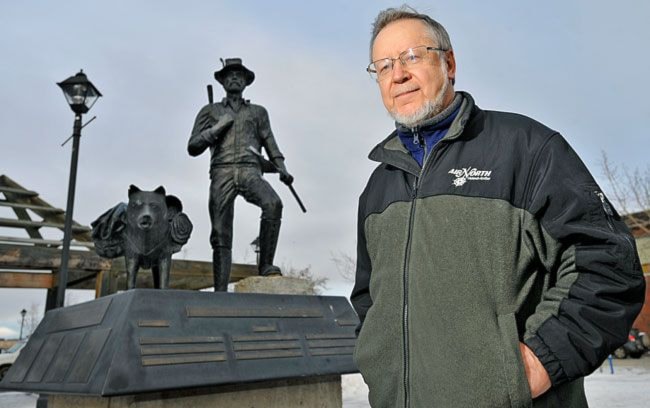Between a rock and a hard place is a pretty good place to be, if you ask Ed Balon.
That’s where he spent a good chunk of the ‘70s, prospecting for rich ore deposits in remote corners of the Yukon.
It was tough work, jumping out of helicopters in the middle of nowhere, looking for clues that could lead to a big find.
Balon and a former colleague, Mike Hamilton, were inducted into the Yukon Prospectors Hall of Fame at a ceremony on Monday night during the Geoscience Forum awards banquet.
They were recognized for three important mineral discoveries they made in the Yukon.
Prospectors of the ‘70s set the stage for a lot a of mining exploration and development that happens today, said Mike Power, president of the Yukon Prospectors Association.
“The 1970s were a golden age when commodity prices were high and oil money came in. It was like, party on. There were a lot of big discoveries back then. We’re playing the greatest hits of the 1970s now in terms of the deposits we’re mining.”
Working for Cordilleran Engineering, Balon and Hamilton played key roles in discovering the Goz Creek deposit in 1973.
The property, located about 180 kilometres northeast of Mayo, now consists of 90 mineral claims.
Based on historic estimates, there could be more than 294 million kilograms of zinc on the site.
Balon and Hamilton were also part of the team that discovered the Logtung deposit between the Swift and Morley rivers in 1976.
“Actually it’s the largest undeveloped tungsten molybdenum deposit of its kind in the world,” said Bolen.
“We didn’t expect to find a big deposit like that but unfortunately it remains undeveloped because it’s low-grade tungsten.”
Balon led the team that discovered the Logan deposit northwest of Watson Lake in 1979.
Extensive diamond drilling between 1979 and 1988 revealed more than 12 million tonnes of zinc and silver.
Born in Three Lakes, Sask. in 1946, Balon earned a diploma in mining engineering technology from the Northern College-Haileybury School of Mines in 1970.
He started working for Cordilleran Engineering soon after, which brought him on exploration surveys all over northern British Columbia, the Yukon and the Northwest Territories.
Prospecting can be physically demanding work.
Most of the time Balon would be in a helicopter with a pilot, plotting sample points on a map and dropping in on various tributaries or branches of a river.
He or a colleague would jump out, collect the finest samples of silt that he could find, and jump back in.
Some prospectors used tools but Balon preferred working with his bare hands, he said.
When territorial governments began doing their own survey sampling in the 1970s, it was at a lower density - about one sample for every 10-15 square kilometres.
But when Balon and his colleagues were sampling, it was at a much higher density: about one sample per one square kilometre.
“As you’re flying over land you have the benefit of spotting any exposed rocks, too,” he said.
For the Logan deposit, Balon spotted a rusty patch on top of the soil.
“You know something is there right away,” he said.
Power said the nomination for Balon and Hamilton came from “experienced people in the mining industry” who felt that the pair hadn’t been properly recognized for their achievements.
“Ed’s well-known in the industry, highly respected and very skillful,” he said.
“To make three significant discoveries like that is something that doesn’t happen very often. He got three here in the Yukon alone but also got some elsewhere.”
Contact Myles Dolphin at
myles@yukon-news.com
